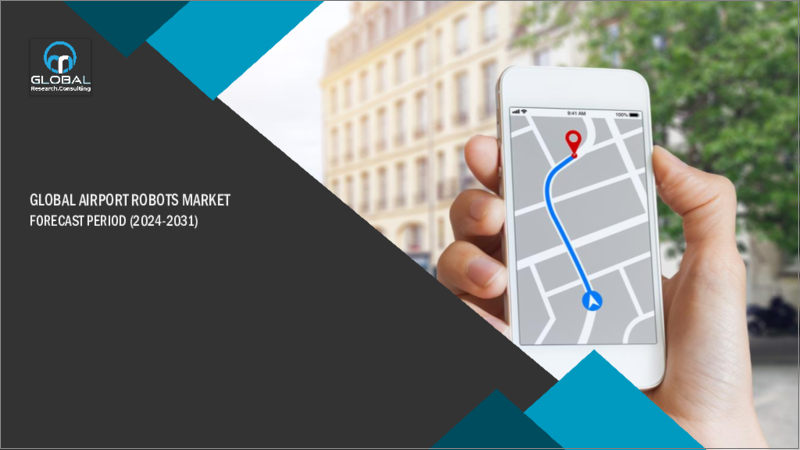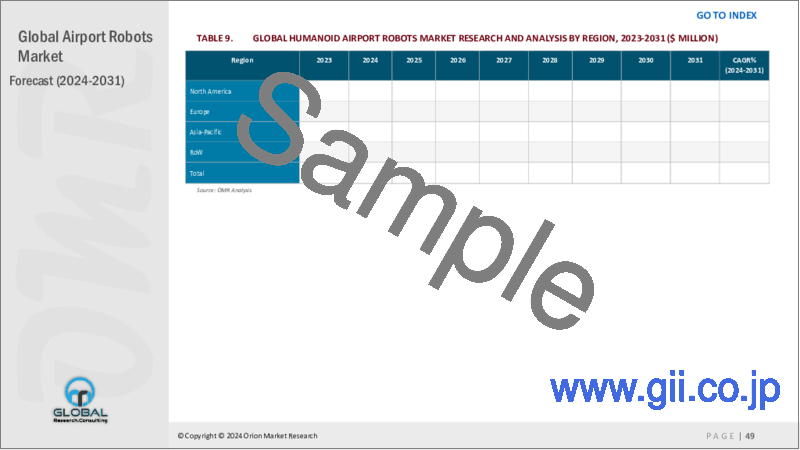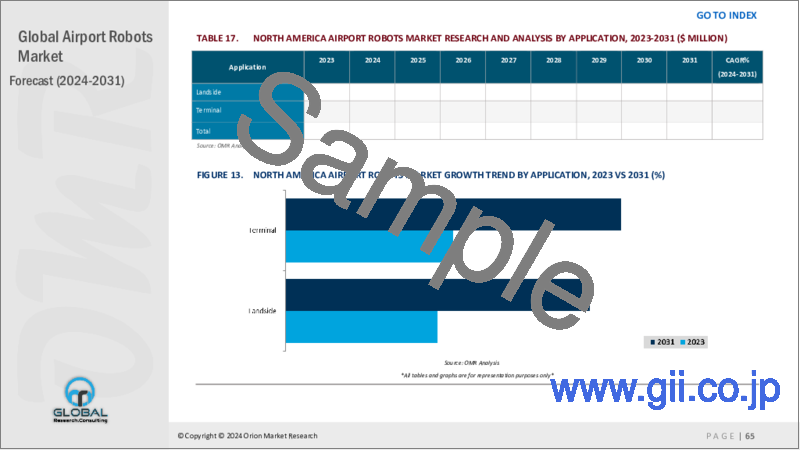|
|
市場調査レポート
商品コード
1483097
空港用ロボットの世界市場、2024-2031年Global Airport Robots Market 2024-2031 |
||||||
カスタマイズ可能
|
|||||||
| 空港用ロボットの世界市場、2024-2031年 |
|
出版日: 2024年04月27日
発行: Orion Market Research
ページ情報: 英文 115 Pages
納期: 2~3営業日
|
全表示
- 概要
- 図表
- 目次
空港用ロボット市場は予測期間(2024-2031年)にCAGR 16.5%で成長すると予測されています。空港用ロボットは、自律的に旅客を支援し、手荷物を扱い、セキュリティを確保し、空港構内の清潔さを維持することで、旅行に革命をもたらします。AI、センサー、ナビゲーションシステムを搭載したこれらの先進的な機械は、業務を合理化し、効率性と旅客体験を向上させる。ガイダンス、言語翻訳、リアルタイム情報を提供し、ターミナルのナビゲーションを最適化します。
市場力学
旅客体験の向上
乗客がロボットが提供する利便性とサポートに慣れるにつれ、より高度な機能性とサービス向上への期待が高まっています。このことが技術革新の原動力となり、メーカー各社は進化する乗客のニーズに対応するため、機能を強化したロボットを開発するようになります。さらに、旅客体験を向上させるために先進的なロボットに投資する空港や航空会社は、競争優位性を獲得します。このため、他の空港も競争力を維持するために追随するようになり、空港用ロボットの市場成長にさらに貢献しています。
ロボット技術への投資の増加が市場を牽引
世界的には、ロボット技術への投資の増加が空港用ロボット産業の成長を牽引しています。こうした投資は、空港エコシステムの運用効率、旅客体験、安全性を向上させる革新的なロボットソリューションの創出と実装を促進し、同時に市場成長を牽引しています。例えば、2023年4月、GMR Innovex傘下のGMRグループは、ロボット技術革新、研究開発のための専用ハブであるRobotics Centre of Excellence(CoE)を立ち上げました。CoEは、空港と航空エコシステムのための画期的なソリューションを育成する共同スペースとして機能します。ロボット企業の発掘とインキュベーションに重点を置き、最先端のソリューションと卓越した技術に対するGMRグループのコミットメントに沿いながら、この分野の進歩を推進することを目的としています。
市場セグメンテーション
世界の空港用ロボット市場を詳細に分析すると、タイプ別とアプリケーション別に分類:
- タイプ別では、ヒューマノイド型と非ヒューマノイド型に細分化されます。
- アプリケーションに基づき、市場はランドサイドとターミナル(空港セキュリティ、搭乗券スキャン、空港手荷物ハンドリング、旅客案内)に分類されます。
非ヒューマノイドが最大セグメントとなる見通し
世界の空港用ロボット市場は、タイプ別にヒューマノイドと非ヒューマノイドに細分化されます。このうち、非ヒューマノイドが最大シェアを占めると予測されます。このセグメントの成長を支える主な要因としては、ヒューマノイド型以外の特殊なロボットソリューションの採用が空港で増加していることが挙げられます。自律走行車、ドローン、ロボットカートは、清掃、監視、荷物管理などさまざまな作業を行う非ヒューマノイド型ロボットの一例です。これらのデバイスは、特定の仕事をするように設計されているため、効率性と汎用性を提供します。このパターンは、空港がさまざまな業務要件を処理するためにさまざまなロボット技術を使用し、手順を合理化し、空港管理全体を向上させるという、業務に特化した自動化への動きを示しています。
空港セキュリティロボットはターミナルサブセグメントで大きな市場シェアを占める
空港セキュリティ強化が重視されるようになったことが、市場成長の原動力となっています。これらのロボットは、アルパワー・ビデオ解析や脅威検知システムなどの高度な監視機能を備えています。警備ロボットはパトロールや監視に使用され、プロアクティブセキュリティ戦略の一環としてリアルタイムの脅威対応や監視を行う。空港環境におけるセキュリティロボットの導入は、空港の安全性に対する関心の高まりと、効果的な監視ソリューションの必要性が主な要因となっています。
地域別展望
世界の空港用ロボット市場は、北米(米国、カナダ)、欧州(英国、イタリア、スペイン、ドイツ、フランス、その他欧州地域)、アジア太平洋地域(インド、中国、日本、韓国、その他アジア地域)、世界のその他の地域(中東とアフリカ、ラテンアメリカ)を含む地域別にさらに細分化されています。
空港用ロボット市場に投資するアジア太平洋諸国
- 中国は世界の空港用ロボットの主要な投資国でありユーザーです。
- 新興国における新規空港プロジェクトの増加により、空港用ロボットの需要が高まっています。
空港用ロボットの世界市場の成長:地域別、2024-2031年
北米が主要市場シェアを占める
全地域の中で北米が大きなシェアを占めているのは、空港用ロボットの需要が高まっているためです。米国には多くの空港があり、旅客体験を向上させるために最新の空港技術が急速に採用されていることが、北米の市場成長を支えていると予想されます。このような拡大は、空港近代化への投資の増加、業務効率の強化への強い注力、先端技術の採用が原動力となっています。例えば、2023年7月、外出中の人々のための健康とウェルネス・ソリューションの権威であるXWELL Inc.は、美容業界向けロボット工学のパイオニアであるClockwork社と提携し、マイアミ国際空港(MIA)のXpresSpaロケーションでClockwork社の次世代完全自律型AI搭載エクスプレスマニキュアの使用を開始しました。この自動化システムは、空港で顧客満足度を高めるために自動化されたサービスを統合するという増加傾向に沿い、乗客に外出先からマニキュアの利便性を提供します。主要空港の存在と、航空部門における技術統合への積極的なアプローチが、旅客支援から警備、保守作業まで、多様な空港業務へのロボット導入におけるこの地域のリーダーシップに貢献しています。
市場競争力を維持するために、市場プレーヤーは提携、合併、買収などの戦略を適用することで、事業拡大や製品開拓にますます注力しています。例えば、SITAは2021年7月、Vaclav Havel Airport Pragueに新世代の旅客処理インフラを導入し、将来的に同空港で完全にタッチレスなモバイル旅客の旅への道を開くと発表しました。
目次
第1章 レポート概要
- 業界の現状分析と成長ポテンシャルの展望
- 調査方法とツール
- 市場内訳
- セグメント別
- 地域別
第2章 市場概要と洞察
- 調査範囲
- アナリストの洞察と現在の市場動向
- 主な調査結果
- 推奨事項
- 結論
第3章 競合情勢
- 主要企業分析
- LG Corporation
- 概要
- 財務分析
- SWOT分析
- 最近の動向
- Hitachi, Ltd.
- 会社概要
- 財務分析
- SWOT分析
- 最近の動向
- ABB Ltd.
- 概要
- 財務分析
- SWOT分析
- 最近の動向
- CYBERDYNE, Inc.
- 概要
- 財務分析
- SWOT分析
- 最近の動向
- 主要戦略分析
第4章 市場セグメンテーション
- 空港用ロボットの世界市場:タイプ別
- ヒューマノイド
- 非ヒューマノイド
- 空港用ロボットの世界市場:アプリケーション別
- ランドサイド/バレットパーキング
- ターミナル
第5章 地域分析
- 北米
- 米国
- カナダ
- 欧州
- 英国
- ドイツ
- イタリア
- スペイン
- フランス
- その他欧州
- アジア太平洋
- 中国
- インド
- 日本
- 韓国
- その他アジア太平洋地域
- 世界のその他の地域
- ラテンアメリカ
- 中東・アフリカ
第6章 企業プロファイル
- Advanced Navigation and Positioning Corporation(ANPC)
- Artiligent Solutions Pvt Ltd
- Avidbots Corp.
- ECA Group
- Knightscope, Inc
- Olivaw GmbH c/o Robotise
- OMRON Corporation
- Ottonomy Inc.
- Pringle Robotics
- Sarcos Technology and Robotics Corp.
- SITA
- SoftBank Group Corp.
- Stanley Robotics
- Universal Robots A/S
- UVD Robots
- Vanderlande Industries BV
- Yape S.r.l
- YUJIN ROBOT Co., Ltd.
LIST OF TABLES
- 1.GLOBAL AIRPORT ROBOTS MARKET RESEARCH AND ANALYSIS BY TYPE, 2023-2031 ($ MILLION)
- 2.GLOBAL HUMANOID AIRPORT ROBOTS MARKET RESEARCH AND ANALYSIS BY REGION, 2023-2031 ($ MILLION)
- 3.GLOBAL NON-HUMANOID AIRPORT ROBOTS MARKET RESEARCH AND ANALYSIS BY REGION, 2023-2031 ($ MILLION)
- 4.GLOBAL AIRPORT ROBOTS MARKET RESEARCH AND ANALYSIS BY APPLICATION, 2023-2031 ($ MILLION)
- 5.GLOBAL AIRPORT ROBOTS FOR LANDSIDE MARKET RESEARCH AND ANALYSIS BY REGION, 2023-2031 ($ MILLION)
- 6.GLOBAL AIRPORT ROBOTS FOR TERMINAL MARKET RESEARCH AND ANALYSIS BY REGION, 2023-2031 ($ MILLION)
- 7.GLOBAL AIRPORT ROBOTS MARKET RESEARCH AND ANALYSIS BY REGION, 2023-2031 ($ MILLION)
- 8.NORTH AMERICAN AIRPORT ROBOTS MARKET RESEARCH AND ANALYSIS BY COUNTRY, 2023-2031 ($ MILLION)
- 9.NORTH AMERICAN AIRPORT ROBOTS MARKET RESEARCH AND ANALYSIS BY TYPE, 2023-2031 ($ MILLION)
- 10.NORTH AMERICAN AIRPORT ROBOTS MARKET RESEARCH AND ANALYSIS BY APPLICATION, 2023-2031 ($ MILLION)
- 11.EUROPEAN AIRPORT ROBOTS MARKET RESEARCH AND ANALYSIS BY COUNTRY, 2023-2031 ($ MILLION)
- 12.EUROPEAN AIRPORT ROBOTS MARKET RESEARCH AND ANALYSIS BY TYPE, 2023-2031 ($ MILLION)
- 13.EUROPEAN AIRPORT ROBOTS MARKET RESEARCH AND ANALYSIS BY APPLICATION, 2023-2031 ($ MILLION)
- 14.ASIA-PACIFIC AIRPORT ROBOTS MARKET RESEARCH AND ANALYSIS BY COUNTRY, 2023-2031 ($ MILLION)
- 15.ASIA-PACIFIC AIRPORT ROBOTS MARKET RESEARCH AND ANALYSIS BY TYPE, 2023-2031 ($ MILLION)
- 16.ASIA-PACIFIC AIRPORT ROBOTS MARKET RESEARCH AND ANALYSIS BY APPLICATION, 2023-2031 ($ MILLION)
- 17.REST OF THE WORLD AIRPORT ROBOTS MARKET RESEARCH AND ANALYSIS BY REGION, 2023-2031 ($ MILLION)
- 18.REST OF THE WORLD AIRPORT ROBOTS MARKET RESEARCH AND ANALYSIS BY TYPE, 2023-2031 ($ MILLION)
- 19.REST OF THE WORLD AIRPORT ROBOTS MARKET RESEARCH AND ANALYSIS BY APPLICATION, 2023-2031 ($ MILLION)
LIST OF FIGURES
- 1.GLOBAL AIRPORT ROBOTS MARKET SHARE BY TYPE, 2023 VS 2031 (%)
- 2.GLOBAL HUMANOID AIRPORT ROBOTS MARKET SHARE BY REGION, 2023 VS 2031 (%)
- 3.GLOBAL NON-HUMANOID AIRPORT ROBOTS MARKET SHARE BY REGION, 2023 VS 2031 (%)
- 4.GLOBAL AIRPORT ROBOTS MARKET SHARE BY APPLICATION, 2023 VS 2031 (%)
- 5.GLOBAL AIRPORT ROBOTS FOR LANDSIDE MARKET SHARE BY REGION, 2023 VS 2031 (%)
- 6.GLOBAL AIRPORT ROBOTS FOR TERMINAL MARKET SHARE BY REGION, 2023 VS 2031 (%)
- 7.GLOBAL AIRPORT ROBOTS MARKET SHARE BY REGION, 2023 VS 2031 (%)
- 8.US AIRPORT ROBOTS MARKET SIZE, 2023-2031 ($ MILLION)
- 9.CANADA AIRPORT ROBOTS MARKET SIZE, 2023-2031 ($ MILLION)
- 10.UK AIRPORT ROBOTS MARKET SIZE, 2023-2031 ($ MILLION)
- 11.FRANCE AIRPORT ROBOTS MARKET SIZE, 2023-2031 ($ MILLION)
- 12.GERMANY AIRPORT ROBOTS MARKET SIZE, 2023-2031 ($ MILLION)
- 13.ITALY AIRPORT ROBOTS MARKET SIZE, 2023-2031 ($ MILLION)
- 14.SPAIN AIRPORT ROBOTS MARKET SIZE, 2023-2031 ($ MILLION)
- 15.REST OF EUROPE AIRPORT ROBOTS MARKET SIZE, 2023-2031 ($ MILLION)
- 16.INDIA AIRPORT ROBOTS MARKET SIZE, 2023-2031 ($ MILLION)
- 17.CHINA AIRPORT ROBOTS MARKET SIZE, 2023-2031 ($ MILLION)
- 18.JAPAN AIRPORT ROBOTS MARKET SIZE, 2023-2031 ($ MILLION)
- 19.SOUTH KOREA AIRPORT ROBOTS MARKET SIZE, 2023-2031 ($ MILLION)
- 20.REST OF ASIA-PACIFIC AIRPORT ROBOTS MARKET SIZE, 2023-2031 ($ MILLION)
- 21.LATIN AMERICA AIRPORT ROBOTS MARKET SIZE, 2023-2031 ($ MILLION)
- 22.MIDDLE EAST AND AFRICA AIRPORT ROBOTS MARKET SIZE, 2023-2031 ($ MILLION)
Airport Robots Market Size, Share & Trends Analysis Report by Type (Humanoid and Non-Humanoid), by Application (Landside and Terminal), Forecast Period (2024-2031)
Airport robots market is anticipated to grow at a CAGR of 16.5% during the forecast period (2024-2031). Airport robots revolutionize travel by autonomously assisting passengers, handling baggage, ensuring security, and maintaining cleanliness within airport premises. These advanced machines, equipped with AI, sensors, and navigation systems, streamline operations, enhancing efficiency and passenger experience. They provide guidance, language translation, and real-time information, optimizing terminal navigation.
Market Dynamic
Enhanced passenger experience
As passengers become accustomed to the convenience and support offered by robots, there's a growing expectation for more advanced functionalities and improved services. This drives innovation and prompts manufacturers to develop robots with enhanced capabilities to meet evolving passenger needs. Moreover, airports and airlines that invest in advanced robotics to enhance passenger experience gain a competitive edge. This encourages other airports to follow suit to remain competitive, further contributing to the market growth of airport robots.
Increased investment in robotics technology to drive the market
Globally, increasing investments in robotic technologies are driving the airport robots industry growth. These investments facilitate the creation and implementation of innovative robotic solutions that improve airport ecosystems' operational effectiveness, passenger experience, and safety while also driving market growth. For instance, in April 2023, GMR Group, a part of GMR Innovex, launched the Robotics Centre of Excellence (CoE) a dedicated hub for robotic innovation, research, and development. The CoE serves as a collaborative space, fostering breakthrough solutions for the airport and aviation ecosystem. With a focus on identifying and incubating robotics firms, it aims to drive advancements in the field, aligning with GMR Group's commitment to cutting-edge solutions and technological excellence.
Market Segmentation
Our in-depth analysis of the global airport robots market includes the following segments by type and application:
- Based on type, the market is sub-segmented into humanoid and non-humanoid.
- Based on application, the market is bifurcated into landside and terminal (airport security, boarding pass scanning, airport baggage handling, and passenger guidance).
Non-humanoid is Projected to Emerge as the Largest Segment
Based on type, the global airport robots market is sub-segmented into humanoid and non-humanoid. Among these, the non-humanoid sub-segment is expected to hold the largest share of the market. The primary factor supporting the segment's growth includes the airport's increased adoption of specialized robotic solutions beyond humanoid forms. Autonomous vehicles, drones, and robotic carts are examples of non-humanoid robots that perform a variety of tasks such as cleaning, surveillance, and managing luggage. These devices offer efficiency and versatility because they are designed to do particular jobs. The pattern shows a move toward task-specific automation, in which airports use various robotic technologies to handle different operational requirements, streamlining procedures and improving overall airport administration.
Airport Security Robots in Terminal Sub-segment to Hold a Considerable Market Share
Increased emphasis on enhancing airport security is driving market growth. These robots are equipped with advanced surveillance capabilities including Al-powered video analytics and threat detection systems. Security robots are used for patrolling and monitoring, and they provide real-time threat response and monitoring as part of a proactive security strategy. The deployment of security robots in airport environments is mostly driven by the growing concern for airport safety as well as the necessity for effective surveillance solutions.
Regional Outlook
The global airport robots market is further segmented based on geography including North America (the US, and Canada), Europe (UK, Italy, Spain, Germany, France, and the Rest of Europe), Asia-Pacific (India, China, Japan, South Korea, and Rest of Asia), and the Rest of the World (the Middle East & Africa, and Latin America).
Asia-Pacific countries to invest in airport robots market
- China is the key investor and user of airport robots around the globe.
- The rising number of new airport projects in emerging economies is increasing the demand for airport robots.
Global Airport Robots Market Growth by Region 2024-2031
Source: OMR Analysis
North America Holds Major Market Share
Among all the regions, North America holds a significant share owing to the presence of rising demand for airport robots. A large number of airports in the US and the fast adoption of modern airport technologies to enhance passenger experience are expected to support the market growth in North America. This expansion is driven by increasing investments in airport modernization, a strong focus on enhancing operational efficiency, and the adoption of advanced technologies. For instance, in July 2023, XWELL Inc., an authority in health and wellness solutions for people on the go, in partnership with Clockwork, a pioneer in robotics for the beauty industry, launched the use of Clockwork's next-generation, fully autonomous, AI-powered express manicure in the XpresSpa location at Miami International Airport (MIA). This automated system offers passengers the convenience of on-the-go manicures, aligning with the growing trend of integrating automated services to enhance customer satisfaction at airports. The presence of major airports and a proactive approach toward technology integration in the aviation sector contribute to the region's leadership in deploying robots for diverse airport operations, ranging from passenger assistance to security and maintenance tasks.
Market Players Outlook
Note: Major Players Sorted in No Particular Order.
The major companies serving the global Airport Robots market include ABB, Ltd., Hitachi, Ltd., OMRON Corporation, LG Corporation, Cyberdyne, Inc., and SITA, among others. The market players are increasingly focusing on business expansion and product development by applying strategies such as collaborations, mergers, and acquisitions to stay competitive in the market. For instance, in July 2021, SITA announced the implementation of its new generation of passenger processing infrastructure at Vaclav Havel Airport Prague, paving the way to a completely touchless, mobile passenger journey at the airport in the future.
The Report Covers:
- Market value data analysis of 2023 and forecast to 2031.
- Annualized market revenues ($ million) for each market segment.
- Country-wise analysis of major geographical regions.
- Key companies operating in the global airport robots market. Based on the availability of data, information related to new product launches, and relevant news is also available in the report.
- Analysis of business strategies by identifying the key market segments positioned for strong growth in the future.
- Analysis of market-entry and market expansion strategies.
- Competitive strategies by identifying 'who-stands-where' in the market.
Table of Contents
1.Report Summary
- Current Industry Analysis and Growth Potential Outlook
- 1.1.Research Methods and Tools
- 1.2.Market Breakdown
- 1.2.1.By Segments
- 1.2.2.By Region
2.Market Overview and Insights
- 2.1.Scope of the Report
- 2.2.Analyst Insight & Current Market Trends
- 2.2.1.Key Findings
- 2.2.2.Recommendations
- 2.2.3.Conclusion
3.Competitive Landscape
- 3.1.Key Company Analysis
- 3.2.LG Corporation
- 3.2.1.Overview
- 3.2.2.Financial Analysis
- 3.2.3.SWOT Analysis
- 3.2.4.Recent Developments
- 3.3.Hitachi, Ltd.
- 3.3.1.Overview
- 3.3.2.Financial Analysis
- 3.3.3.SWOT Analysis
- 3.3.4.Recent Developments
- 3.4.ABB Ltd.
- 3.4.1.Overview
- 3.4.2.Financial Analysis
- 3.4.3.SWOT Analysis
- 3.4.4.Recent Developments
- 3.5.CYBERDYNE, Inc.
- 3.5.1.Overview
- 3.5.2.Financial Analysis
- 3.5.3.SWOT Analysis
- 3.5.4.Recent Developments
- 3.6.Key Strategy Analysis
4.Market Segmentation
- 4.1.Global Airport Robots Market by Type
- 4.1.1.Humanoid
- 4.1.2.Non-Humanoid
- 4.2.Global Airport Robots Market by Application
- 4.2.1.Landside/Valet Parking
- 4.2.2.Terminal
5.Regional Analysis
- 5.1.North America
- 5.1.1.United States
- 5.1.2.Canada
- 5.2.Europe
- 5.2.1.UK
- 5.2.2.Germany
- 5.2.3.Italy
- 5.2.4.Spain
- 5.2.5.France
- 5.2.6.Rest of Europe
- 5.3.Asia-Pacific
- 5.3.1.China
- 5.3.2.India
- 5.3.3.Japan
- 5.3.4.South Korea
- 5.3.5.Rest of Asia-Pacific
- 5.4.Rest of the World
- 5.4.1.Latin America
- 5.4.2.Middle East and Africa
6.Company Profiles
- 6.1.Advanced Navigation and Positioning Corporation (ANPC)
- 6.2.Artiligent Solutions Pvt Ltd
- 6.3.Avidbots Corp.
- 6.4.ECA Group
- 6.5.Knightscope, Inc
- 6.6.Olivaw GmbH c/o Robotise
- 6.7.OMRON Corporation
- 6.8.Ottonomy Inc.
- 6.9.Pringle Robotics
- 6.10.Sarcos Technology and Robotics Corp.
- 6.11.SITA
- 6.12.SoftBank Group Corp.
- 6.13.Stanley Robotics
- 6.14.Universal Robots A/S
- 6.15.UVD Robots
- 6.16.Vanderlande Industries BV
- 6.17.Yape S.r.l
- 6.18.YUJIN ROBOT Co., Ltd.





